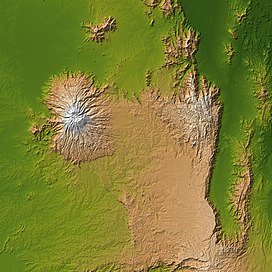Loading AI tools
Volcano in Kenya and Uganda From Wikipedia, the free encyclopedia
Mount Elgon is an extinct shield volcano on the border of Uganda and Kenya,[4] north of Kisumu and west of Kitale. The mountain's highest point, named "Wagagai", is located entirely within Uganda.[1][5] Although there is no verifiable evidence of its earliest volcanic activity, geologists estimate that Mount Elgon is at least 24 million years old, making it the oldest extinct volcano in East Africa.[6] The mountain's name originates from its Maasai name, “Ol Doinyo Ilgoon” (Breast Mountain).[7]
| Mountain Elgon | |
|---|---|
| Wagagai (summit) | |
 Mount Elgon (left) and Great Rift Valley (right) | |
| Highest point | |
| Elevation | 4,321 m (14,177 ft)[1] Ranked 17th in Africa |
| Prominence | 2,458 m (8,064 ft)[1] |
| Isolation | 339 km (211 mi)[2] |
| Listing | Ultra |
| Coordinates | 01°07′06″N 34°31′30″E[1] |
| Geography | |
| Topo map(s) | Mount Elgon Map and Guide[3] |
| Geology | |
| Rock age | Miocene origin |
| Mountain type | Shield volcano |
| Last eruption | Unknown |
| Climbing | |
| First ascent | 1911 by Kmunke and Stigler |
| Easiest route | Scramble |
Mount Elgon is a massive solitary volcanic mountain on the border of eastern Uganda and western Kenya. Its vast form, 80 kilometres (50 mi) in diameter, rises 3,070 metres (10,070 ft) above the surrounding plains. Its cooler heights offer respite for humans from the hot plains below, and its higher altitudes provide a refuge for flora and fauna.
Mt. Elgon consists of five major peaks:
Other features of note are:
The mountain soil is red laterite. The mountain is the catchment area for several rivers such as the Suam River, which becomes the Turkwel downstream and drains into Lake Turkana, and the Nzoia River and the Lwakhakha River, which flow to Lake Victoria. The town of Kitale is in the foothills of the mountain. The area around the mountain is protected by two Mount Elgon National Parks, one on each side of the international border.
A population of African bush elephants is present around the mountain that ventures deep into caves to access salt licks. This population was formerly present around the entire mountain, but has since been reduced to the Kenyan side, where they venture into Kitum Cave.[13]
There are several disjunct populations of mammal species that are restricted to Mount Elgon, including the Elgon shrew (Crocidura elgonius), Rudd's mole-rat (Tachyoryctes ruddi), and Thomas's pygmy mouse (Mus sorella). There are also several disjunct populations of rare bird species, including Sharpe's longclaw (Macronyx sharpei), Hunter's cisticola (Cisticola hunteri), Jackson's spurfowl (Pternistis jacksoni), and the Elgon francolin (Scleroptila elgonensis).[14]
An endemic subspecies of the bushbuck (Tragelaphus scriptus heterochrous) is restricted to the mountain. The possibly extinct Du Toit's torrent frog (Arthroleptides dutoiti), considered an EDGE species due to its evolutionary distinctiveness, is known only from a single specimen collected on the Kenyan side of the mountain.[15]

Some rare plants are found on the mountain, including Ardisiandra wettsteinii, Carduus afromontanus, Echinops hoehnelii, Ranunculus keniensis, and Romulea keniensis.[16]

Mount Elgon and its tributaries are home to five tribes: the Bagisu, the Mbay, Sor, Sapiiny, Koony, Someek, Pook, and the Ogiek, better known in the region under the derogatory umbrella term Ndorobo.[17]
Seamless Wikipedia browsing. On steroids.
Every time you click a link to Wikipedia, Wiktionary or Wikiquote in your browser's search results, it will show the modern Wikiwand interface.
Wikiwand extension is a five stars, simple, with minimum permission required to keep your browsing private, safe and transparent.